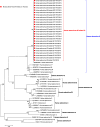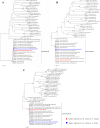An outbreak of epidemic keratoconjunctivitis caused by human adenovirus type 8 in primary school, southwest China
- PMID: 31307413
- PMCID: PMC6631456
- DOI: 10.1186/s12879-019-4232-8
An outbreak of epidemic keratoconjunctivitis caused by human adenovirus type 8 in primary school, southwest China
Abstract
Background: Two outbreaks of epidemic keratoconjunctivitis (EKC) occurred successively with an interval of 5 days in two primary boarding schools in Weixi Lisu Autonomous County, Diqing, and Tibetan Autonomous Prefecture, Yunnan. The aims of this study were to determine the intensity and characteristics of the outbreaks, as well as the clinical manifestations in the patients, the risk factors for infection and the pathogen responsible for the two outbreaks.
Methods: An outbreak investigation was conducted in two primary schools, and a case-control study including patients from the Weixi County Ethnic Primary School was performed. Relevant specimens were collected according to the case definition, and next-generation sequencing was employed to identify the pathogen. An epidemiological investigation method was used to analyse the related epidemiological characteristics, such as risk factors. The phylogenetic tree was constructed by MEGA 7.0.
Results: A total of 331 acute conjunctivitis cases, including probable cases of EKC, were reported in the two schools, and the attack rates were 30.59% (171/559, 95%CI: 26.76-34.42) and 20.41% (160/784, 95%CI: 17.58-23.24), respectively. Cases occurred in all grades and classes in both schools, and only one staff member in each school presented illness. The epidemics lasted for 54 days and 45 days, respectively. The patients had typical manifestations of EKC, such as acute onset, follicular hyperplasia, pseudomembrane formation, preauricular lymphadenopathy, corneal involvement and blurred vision, and a relatively long disease course (average 9.40 days, longest 23 days and shortest 7 days). The risk factor for infection was close contact with a patient or personal items contaminated by a patient. The pathogen responsible for the outbreaks was HAdV-8. The virus was highly similar to the 2016 HAdV-8 strain from Tibet, China.
Conclusions: This study strongly suggests that HAdV-8 could lead to serious consequences. This is the second report of a HAdV-8-associated EKC outbreak in mainland China. Tibetan HAdV-8 might be circulating in southwest China; therefore, it is necessary to monitor the pathogens causing acute conjunctivitis in this area.
Keywords: Epidemic Keratoconjunctivitis; Human adenovirus 8; Phylogenetic; Risk factors.
Conflict of interest statement
The authors declare that they have no competing interests.
Figures



References
MeSH terms
Substances
Grants and funding
LinkOut - more resources
Full Text Sources

